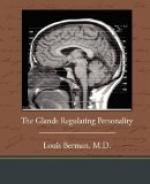ENDOCRINE ANALYSIS
The modes of classification glimpsed at are certainly exceedingly broad and sweeping. It is well enough to establish types and classes. But beneath them are sheltered the infinite possibilities of permutations and combinations, which explain the countless variety and complexity of form and function. Every individual born among the vertebrates, for example, must have a certain definite amount and percentage of pituitary gland, anterior and posterior, pineal, thyroid, parathyroid, thymus, adrenal, pancreas, interstitial and so on. Now if, to state it in terms of percentages, for the sake of argument, the pituitary is 25, the pineal 10, the thyroid 36, the parathyroids 15, the thymus 29, the adrenals 60, the pancreas 49, the interstitials 72 (the gland when acting maximally to be graded as 100), we see at once how different such an individual must be from one who has, say, pituitary 84, pineal 39, thyroid 26, parathyroid 42, adrenals 96, pancreas 22 and interstitials 89. One obtains at once from the contrasts of such figures some idea of the possibilities. As each point plus or minus must count to produce some difference in the individual, the results are manifest. Varying within the numerical limits imposed by genus, species, variety and family (which limits are probably responsible for the persistence of the particular genus, species, variety, or family) the individual becomes an individual because of the relative values of the percentages in his blood and tissues of these different internal secretions. We thus begin to gain an insight into the patterns according to which men, women and animals are woven.
We are, as yet, far from an exact endocrine analysis of the individual. But we know that the endocrines rule over growth and nutrition, a vast dominion which incorporates every organ and every tissue. By enhancing or retarding the nutritional changes, the growth of the organ or tissue is favored or restricted. The size and shape of an individual, as a whole, as well as of the specialized cell masses composing him, as hands and feet, the nose and ears, and so on, are therefore controlled by them. Whether an organism is to be tall or short, lean or corpulent, graceful or awkward, is decided by their interactions. These, like human covenants, vary with the different reactions of the parties to the contract. And so a great deal depends upon whether they work harmoniously or discordantly, and upon which does the most work and which the least.
Undersecretion and Oversecretion




